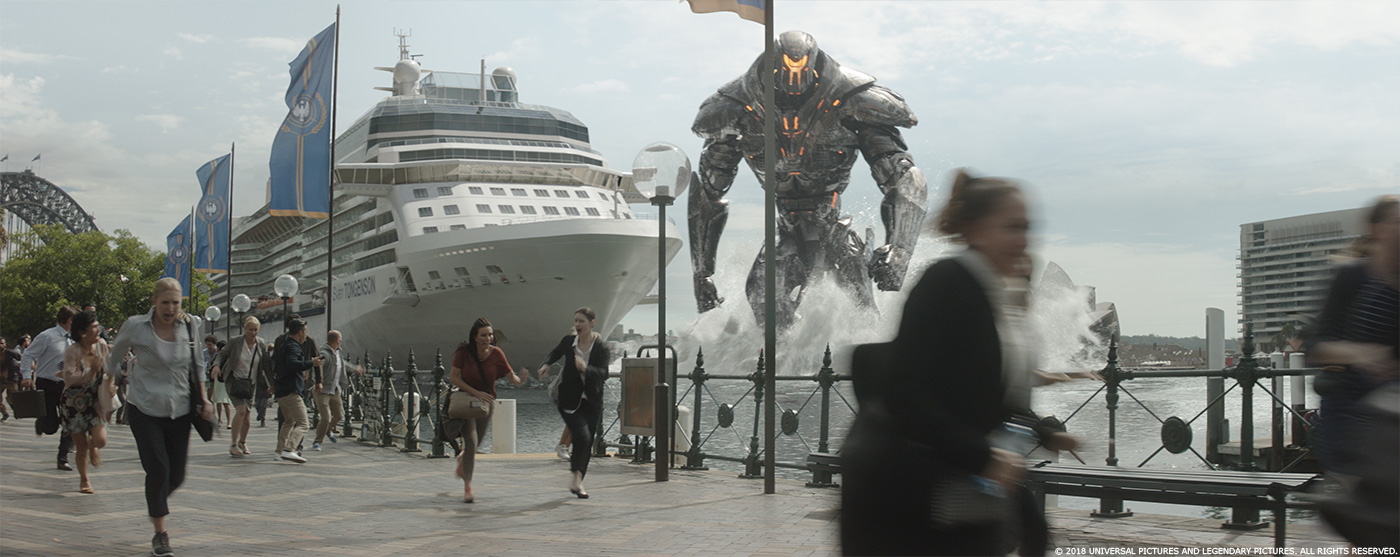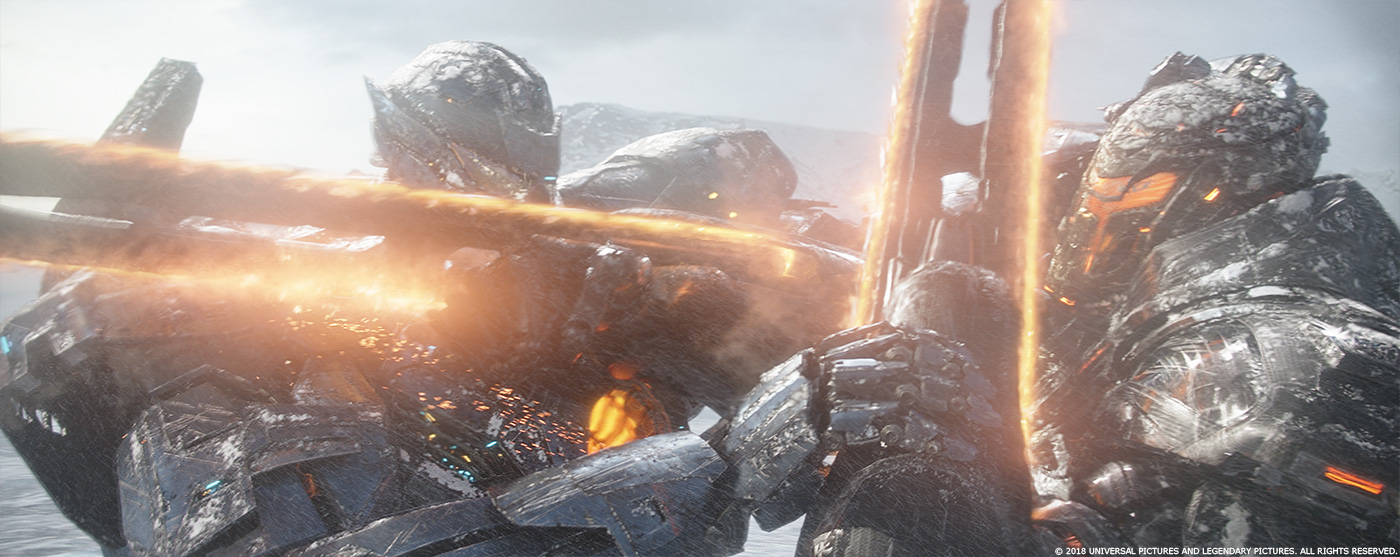In 2015, Peter Chiang explained the work of DNEG on EXODUS: GODS AND KINGS. He then worked on STAR TREK BEYOND. Today he tells us about PACIFIC RIM: UPRISING.
How was the collaboration with director Steven S. DeKnight?
Steven was a real pleasure to work with. From the outset I felt he was happy to collaborate on so many areas of the process. He clearly understood where the milestones were in order to keep us on schedule and made the whole experience one to remember.
What was his approach and expectations about the visual effects?
It was his first FX heavy project and he was very willing to learn, wanting to know the important steps. We were fortunate to have Dylan Highsmith as editor who really helped mediate all the sessions.
How did you organize the work with your VFX Producer and between the various DNEG offices?
As with all projects you try to break up the work to minimise asset doubling and of course cost is a factor. Theresa Corrao (VFX Producer) and I divided up the show into four areas: DNEG, Atomic Fiction, Turncoat Pictures and an In-House team.
Matthew Plummer and Sara Khangaroot were instrumental in placing the 1059 DNEG shots across the London, Vancouver and Mumbai sites.
Annie Normandin looked after the 326 Atomic Fiction shots in Montreal and Oakland.
Ryan Urban looked after 18 shots for Turncoat Pictures.
Theresa and Dominic Sidoli as well as everyone in post also looked after the 216 In-House shots.
Can you tell us more about the previz and postviz work?
Previs was handled by three companies:
Halon, Supervised by Brad Alexander and Ryan McCoy,
The Third Floor, Supervised by Mark Nelson and Martin Chamney,
Day For Nite, Supervised by Andreas Hikel,
When I arrive in Sydney with Theresa, two weeks before principle photography, a fair amount had already started. I had several meetings with Steven going through all the sequences determining what needed to be changed. We used a tabletop with toys from the first film to choreograph the action sequences in the third act so we could understand their relationship. This gave us markers for where we wanted to design cool shots. In Post-vis new sequences were written and re-imagined. Halon and DNEG took up the mantle.
Where was filmed the different parts of the movie?
Sydney served as future Sydney.
The Fox Studios was the base for all Conn-pods and most interiors. Several exterior locations around Sydney were chosen for Shatterdome and Shao Industries.
Brisbane served as future Santa Monica.
Santa Monica pier was used for the flashback.
Qingdao was used for some interiors.
Iceland served as Siberia and Seoul and Busan served as Mega Tokyo.
Shanghai served as future Shanghai Shao Industry HQ.
The movie features new Jaegers and Kaijus. How did you work with the art department for them?
The art department under Production Designer Stefan Dechant had already worked with the ILM Art Department and had already designed a lot of the Jaegers, Scrapper and the three main Kaiju. VFX came in and finished designing Mega Kaiju, some generic Jaegers, the Drone Kaiju and the breach Kaiju. Once animation and rigging got under way some minor alterations to the original shapes had to be modified.
Can you tell us more about their rigging and animation?
Animation for the Jaegers was driven by Motion Capture which was choreographed by Aaron Gilman (DNEG Animation Director) and then certain axis either taken out or altered to make the capture feel more robotic. Additional animation was layered on a case by case basis. The Kaiju’s were all key frame animated.
How did you work with the SFX and stunts teams?
SFX did a fantastic job under the leadership of Dan Oliver. We always start by trying to do as much physically, I think today the demarcation is clearer and abilities are much clearer. Dan built fully working gimbals and Conn-pods for all the Jaegers and Scrapper. Hatches and mechanical rigs that allowed the actors to interact with something physical plus the usual array of pyrotechnic work.
How does the massive sizes of the Jaegers and Kaijus affects the animation?
There is always a payoff between keeping the action fast moving, as an exciting sequence and the respect for a real physical object moving at the correct speed. If we’d kept everything moving at the correct speed we would have created quite a slow sequence. We cheated a lot.
Can you tell us more about the shaders and textures?
They were based on the real world from real objects.
How did you manage the various lighting conditions?
We shot a live action plate for every VFX shot in the film so once we placed the Jaeger or Kaiju into the shot it gave us a good starting point to start move the lighting around to best effect.
Which Jaegers or Kaijus was the most complicated to created and why?
The Mega Kaiju because of the amalgamation of Raijin, Shrikethorn and Hakuja.
Which Jaeger is your favorite?
I enjoyed working out Gipsy Avenger, Scrapper and Obsidian Fury.
How did you created the massive environment of Tokyo and the Mount Fuji?
We photographed a lot of buildings in Korea and designed a lot of bespoke ones. I had the privilege of flying in a helicopter around Mount Fuji to take photographs.
The fights occurs massive destructions in Tokyo. Can you explain in details about these simulations?
Storyboards and the “Toy Table” work out the action.
Previs works out the camera move and basic animation movement.
VFX then replaces this shot with a solid scene file honouring the real assets and environment with final animation and lighting direction.
Animation approved allows the FX simulation to run and be worked out.
Once all approved the final composite is done with the final renders.
The movie is full of holograms. How did you help the cast and crew on-set to visualize their actions?
There were three vendors that worked on the graphics for the film:
Blind under the Supervision of Andrew Booth handled Scrapper.
Territory under the Supervision of Peter Eszenyi handled all the Jaeger Conn-pods and some of the monitors in Shatterdome.
Atomic Fiction under the Supervision of Ryan Tudhope handled the War Room and Gottlieb’s lab.
Can you explain in details about their design and creation?
We wanted to update the graphics from the first film as this film takes place 10yrs later. There were really three distinct design styles.
Scrapper was more fun, hacked and designed off of PPDC technology with a personal touch of Amara. PPDC we kept very military, functional and colourful to distinguish each Jaeger but still working off a single operating system.
Shao Industries was the most advanced, slicker, more stylish and designed.
Which sequence or shot was the most complicated to create and why?
The shot where Gipsy Avenger leaps through a building onto Mega Kaiju was the most difficult shot in the show. Not only because of the running time but also because it involved every aspect of VFX we were dealing with i.e. destruction, animation, effects, environment, lighting, shot design etc. It was further compounded by the fact that the sequence changed and originally it was going to be another creature but a late decision made it Mega Kaiju.
Can you tell us how you choose the various VFX vendors?
They were chosen because of past working relationships and cost.
Can you tell us more about your collaboration with their VFX supervisors?
Part of the fun of this great job is working with other Supervisors. Everyone contributes to the team effort and I’m never surprised by the great ideas that are presented during our reviews. It makes you realise just how diverse our thinking is and keeps you grounded and even more challenged.
Peter Bebb was the VFX Supervisor for DNEG, Ryan Tudhope was the VFX Supervisor for Atomic Fiction, Ryan Urban was the VFX Supervisor for Turncoat Pictures and Brian Battles and Peter Sauvey were the VFX Supervisors for the In-House team.
The vendors are all around the world. How did you proceed to follow their work?
Every day in post was spent in the theatre doing cineSync sessions and reviewing high res files with the vendors. We would start in the morning with London and then follow the world around, Montreal, Vancouver, Oakland, Los Angeles, Mumbai. In between and whenever we could, we would present to Steven and Editorial for sign off.
What is your favorite shot or sequence?
Too many great shots but the Third Act was a great sequence to work out and design.
What is your best memory on this show?
Working with some amazing people in amazing places around the world!
How long have you worked on this show?
I started in October 2016 and finished January 2018.
What’s the VFX shots count?
Total 1598 shots.
What was the size of your on-set team?
We had about 15 people covering on-set data wrangling, lidar, texture shoot, VFX office and co-ordinators.
What is your next project?
Taking time off at the moment!
A big thanks for your time.
// WANT TO KNOW MORE?
DNEG: Dedicated page about PACIFIC RIM: UPRISING on DNEG website.
© Vincent Frei – The Art of VFX – 2018






















